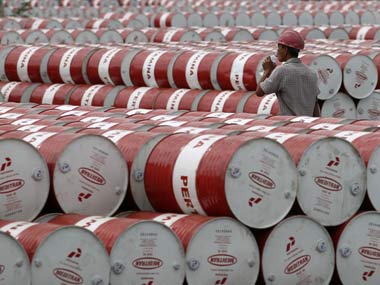India’s imports growth has softened considerably over the past two months, as per latest official data. In September and October, imports have grown 17.2 percent and 17.1 percent respectively, making it two months of relatively slow growth. In contrast, imports grew by an average of around 35 percent during April-August.
That’s the good news. The bad news is that exports have shown their first decline in October (10.8 percent).While the detailed release for October is not out yet, the September numbers reflect the possibility that the recent subdued import numbers are due to a combination of factors - including contained crude oil prices, a sharp rupee depreciation and softening domestic demand.
[caption id=“attachment_127637” align=“alignleft” width=“380” caption=“The entire decline in oil imports might not be explained by crude prices alone.Reuters”]  [/caption]
Imports grew by 17.2 percent in September (to $34.6 billion), in comparison with the same period of the previous year. With the exception of April, when the numbers had declined, at least in part on a strong base effect, imports have grown in the current fiscal year at consistently 40 percent plus rates.
The latest decline is largely on the back of oil imports, which account for a third of India’s total imports. Growth in oil imports tumbled to 17.2 percent over September 2010 (reaching an absolute level of $9.2 billion), when it had grown by 37 percent as crude prices were muted.
With India importing most of its crude oil requirements, it was thus to be expected that a decline in crude prices will have a value impact on the country’s oil imports as well.However, the entire decline in oil imports might not be explained by crude prices alone. Some answers are to be found in the level of demand as well. Non-oil imports, which are a measure of demand among Indian consumers, has also seen some decline in growth though it is really not as appreciable as that for oil imports.
Growth in non-oil imports has declined to 34 percent in September, the slowest growth in five months. (Their September value is $25.4 billion). While this growth is still quite robust - and higher than the 27 percent witnessed during September 2010, it is still lower than the 2011-12 average so far of about 39 percent.
This could be a one-off event, but it is as likely that it reflects some softening in consumer demand. India’s industrial production figures have been coming off, which is also expected to reflect in non-oil imports since capital goods imports form a bulk of these.
In the recent past, the rupee has also sharply depreciated against the US dollar, which makes imports expensive for India. This could further impact India’s non-oil imports going forward. However, oil imports could actually witness a rise in the coming busy season due to the relative inelastic demand for the commodity and the fact that crude prices have inched up over recent weeks.
How imports ultimately play out remains to be seen, but it is likely that in a scenario of depreciation in the currency and softening domestic economic activity, import demand will, in fact, soften.
| India’s merchandise imports |
|---|
| Sep-10 |
| Aug-11 |
| Sep-11 |
| Source: Ministry of Commerce and Industry, Orbis Economics Estimates |


)
)
)
)
)
)
)
)
)



